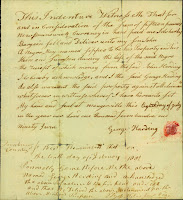And I give and bequeath all my negroes (except one negro wench called Betty which I give to my son William and one negro girl not above the age of twelve years which I give to my granddaughter Rebecca Aitshison Ellegood to be chosen by my said granddaughter) and all my horses, neat cattle and livestock of every kind…(Will of Col. Jacob Ellegood, Dumfries, 1802)
 |
Fredericton Region Museum, 2020; Artist: Claire Vautour |
Freedom was not the case for all, however, since many Black Loyalists arrived in New Brunswick as slaves or indentured servants. Such was the case for Nancy, who came to Fredericton from Maryland 1785/86 as a slave to Caleb Jones. Slavery was legal in New Brunswick until 1834. Up until then, people could be bought or sold as property—with they and their children receiving no hope of freedom for as long as they lived. A typical bill of sale would be worded as such:
 |
George Harding's Bill of Sale for Sippeo, February 10, 1802; Provincial Archives of New Brunswick, MC1106 |
This Indenture witnesses that for and in the consideration of the sum of fifteen pounds New Brunswick currency paid me, I do hereby bargain, sell and deliver unto my son John, a negro boy named Sippeo to be his property and his heirs and successors during the life of the said negro, the receipt of which money from the said John HARDING I do hereby acknowledge; and I, the said George HARDING, do also warrant the said property against all claimants whatsoever. In witness whereof I do hereby set my hand and seal at Maugerville, this eighth day of July in the year of our Lord 1797. – Be It remembered that on the tenth day of February 1802, personally appeared before me the above named George Harding and acknowledged the above signature to be his hand and seal and that he delivered the above instrument for the above mentioned purposes. Elijah MILES, J.P.
 |
| Mrs. Gabriel DeVeber, Burton (slaveowner); New Brunswick Museum, www.nbm-mnb.ca, 2014.21.3 |
Many prominent Loyalists were slaveowners—including Col. Jacob Ellegood and Judge Isaac Allen of Kingsclear; Major John Coffin, Rev. Jonathan Odell, Cpt. William Bailey, and Cpt. Stair Agnew, all of Fredericton; Lt. Gabriel Deveber of Burton; and George Harding and Daniel Sickles of Maugerville (to name only a few). Historian Watson Smith has estimated that more than 400 “servant” slaves were brought to the region between 1783 and 1784.
 |
| Sally and Adam Wise christening, July 28, 1798, property of Col Ellgood; New Brunswick Genealogical Society, Inc., Anglican Registers Project |
By the turn of the century, however, the anti-slavery movement had become very active in this province. Two of the leaders in this initiative were Saint John lawyers Samuel Denny Street and Ward Chipman. In 1800 they challenged the legality of slavery in New Brunswick by bringing to trial the case of Nancy, an individual who had been enslaved for more than fourteen years.
 |
| Samuel Denny Street, 1752-1830, UNB Archives & Special Collections |
 |
| Ward Chipman, 1754-1824, UNB Archives & Special Collections |



